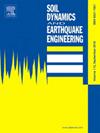Probabilistic prediction of hysteretic curves of corroded reinforced concrete columns based on Bayesian theory
IF 4.2
2区 工程技术
Q1 ENGINEERING, GEOLOGICAL
引用次数: 0
Abstract
The reinforced concrete (RC) columns eroded by chloride ions are more likely to be damaged under seismic loading. In this paper, a prediction method of hysteretic curve of corroded RC columns based on asymmetric Bouc-Wen-Baber-Noori (BWBN) model is proposed. Firstly, the effects of 13 control parameters on the asymmetric BWBN model are analyzed. Then, the test data of the quasi-static test of corroded RC columns are collected. The differential evolution algorithm of Bayesian theory is used to identify the parameters of the asymmetric BWBN model, and the prior distribution range of the parameters is discussed. Through the correlation analysis between the parameters of the corroded RC columns and the parameters of the asymmetric BWBN model, it is found that there is a poor correlation between the both parameters, and the Bayesian neural network optimized by the Gaussian process is used to establish the relationship between the two parameters. The results show that by inputting the parameters including corrosion ratio of corroded column members, the well-trained Bayesian neural network is used to predict the parameters of asymmetric BWBN model, and then the hysteresis curve of corroded RC columns under the earthquake can be reasonably predicted by asymmetric BWBN model. And inputting the corrosion ratio directly is more accurate in predicting than inputting other design parameters that consider the impact of correction.
求助全文
约1分钟内获得全文
求助全文
来源期刊

Soil Dynamics and Earthquake Engineering
工程技术-地球科学综合
CiteScore
7.50
自引率
15.00%
发文量
446
审稿时长
8 months
期刊介绍:
The journal aims to encourage and enhance the role of mechanics and other disciplines as they relate to earthquake engineering by providing opportunities for the publication of the work of applied mathematicians, engineers and other applied scientists involved in solving problems closely related to the field of earthquake engineering and geotechnical earthquake engineering.
Emphasis is placed on new concepts and techniques, but case histories will also be published if they enhance the presentation and understanding of new technical concepts.
 求助内容:
求助内容: 应助结果提醒方式:
应助结果提醒方式:


